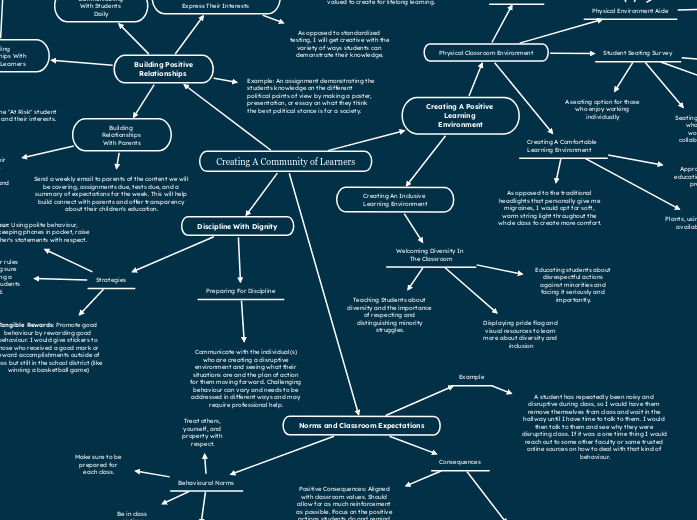Creating A Community of Learners
Building Positive Relationships
Create A Space Where Students Can Discover and Express Their Interests
As opposed to standardized testing, I will get creative with the variety of ways students can demonstrate their knowledge.
Being open to new ideas and letting students express their opinions and their point of view being acknowledged and valued to create for lifelong learning.
Having learning activities that are collaborative and focus on team building and fostering relationships.
Communicating With Students Daily
Building Relationships With "At Risk" Learners
Looking for warning signs: Declining academic performance, low attendance, changes in behaviour, social issues.
Confront any rumours or suspicious behaviour in a professional manner. Create for an open space and keep a positive and judgment-free space for students.
Engage more frequently with the "At Risk" student and focus on supporting them and their interests.
Building Relationships With Parents
Being clear with parents about what their child is learning in school with a course outline. As well as if they ever need to contact me, I will provide clear contacts and times that I am available.
Send a weekly email to parents of the content we will be covering, assignments due, tests due, and a summary of expectations for the week. This will help build connect with parents and offer transparency about their children's education.
Example: An assignment demonstrating the students knowledge on the different political points of view by making a poster, presentation, or essay on what they think the best political stance is for a society.
Creating A Positive Learning Environment
Physical Classroom Environment
Organization
Offering students extra supplies, with a limit. Unless there are extenuating circumstances.
Making sure things are organized and easily identifiable with labels.
Physical Environment Aide
Standing Desks
Fidget Toys/Stim Toys
Quiet Corners for learning silently and individually
Wiggle Chairs
Student Seating Survey
A seating option for those who enjoy working individually
Seating for those who enjoy working collaboratively
Creating a seating arrangement with who works well with who and who they enjoy working with.
Having students advocate for where they would like to sit with whom under the agreement that they behave and aren't a distraction from learning.
Creating A Comfortable Learning Environment
As opposed to the traditional headlights that personally give me migraines, I would opt for soft, warm string light throughout the whole class to create more comfort.
Plants, using sunlight from available windows.
Appropriate poster displaying educational material and students proud works on the wall.
Creating An Inclusive Learning Environment
Welcoming Diversity In The Classroom
Teaching Students about diversity and the importance of respecting and distinguishing minority struggles.
Displaying pride flag and visual resources to learn more about diversity and inclusion
Educating students about disrespectful actions against minorities and facing it seriously and importantly.
Discipline With Dignity
Strategies
Model Ideal Behaviour: Using polite behaviour, maintaining eye contact, keeping phones in pocket, raise concerns about one another's statements with respect.
Documenting rules: Going over rules verbally as a class, and making sure they aren't forgotten by having a document easily accessible to students so they clearly understand.
Tangible Rewards: Promote good behaviour by rewarding good behaviour. I would give stickers to those who received a good mark or reward accomplishments outside of class but still in the school district (like winning a basketball game)
Preparing For Discipline
Communicate with the individual(s) who are creating a disruptive environment and seeing what their situations are and the plan of action for them moving forward. Challenging behaviour can vary and needs to be addressed in different ways and may require professional help.
Norms and Classroom Expectations
Behavioural Norms
Treat others, yourself, and property with respect.
Make sure to be prepared for each class.
Be in class on time.
Listen to teacher and others while speaking.
Consequences
Positive Consequences: Aligned with classroom values. Should allow for as much reinforcement as possible. Focus on the positive actions students do and remind them of those actions (praise) to create a positive environment.
3 Types: Tangible, social, and activity
Negative Consequences: Appropriate for grade, include consequences that matter to students and that they don't want to happen, deliver quickly, privately, and without emotion.
Example
A student has repeatedly been noisy and disruptive during class, so I would have them remove themselves from class and wait in the hallway until I have time to talk to them. I would then talk to them and see why they were disrupting class. If it was a one time thing I would reach out to some other faculty or some trusted online sources on how to deal with that kind of behaviour.
